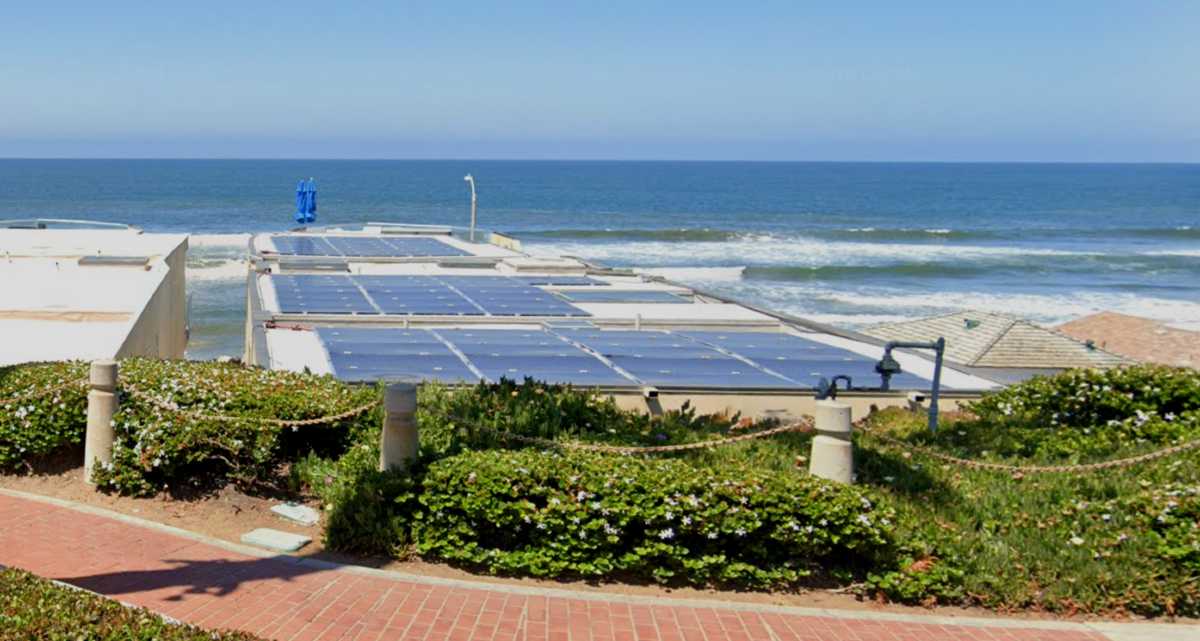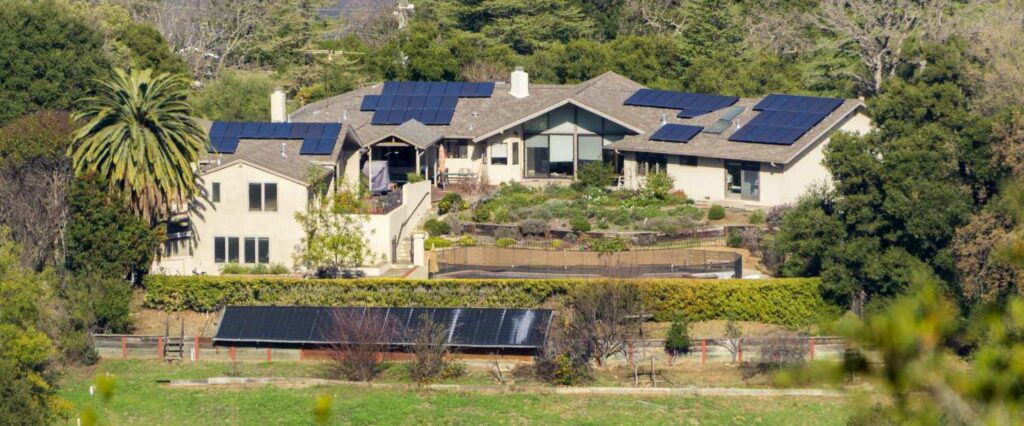While solar panels are a costly investment, they come with multiple advantages for homeowners. They can reduce your energy bills, enhance property values and are environmentally friendly. Aviara Solar has a team of solar panel installation experts who can assist with installing long-lasting solar panels in nearly every home type throughout San Diego County. Let’s take a closer look at all the costs, benefits and details involved with solar and solar panel installations in San Diego.
How Do Solar Panels Work?

Every panel is comprised of small elements known as PV (photovoltaic) cells. Photovoltaic refers to the conversion of light to energy. PV cells function when photons (light particles) release electrons from atoms, which stimulates an electrical current. The more cells a panel has and the more panels are on hand, the more electricity is generated. Read more on how solar panels work…
The Benefits Of Solar Panel Installation In San Diego?
- Among other states in the country, California has enormously high energy bills. Such costs can be minimized – if not eliminated – through the use of solar panels. Granted, cost reductions are based on how big a home is and the amount of energy it uses. San Diego Gas and Electric provides a net metering system for solar customers. When your solar panels produce more power than necessary, your electric meter will show a reversal. In other words, you are providing power to the grid rather than using it. As a result, you will be issued a credit on your energy bill.
- This will help you save thousands of dollars over a three year span, though the duration is malleable. After all, you are credited for the surplus power that you push back into the power grid. This whole process can substantially raise the value of your property as solar panel-powered homes tend to get sold quicker along with being a worthwhile investment, even if you have plans to relocate at some point. Further, solar energy is a friendly to the environment since it doesn’t use fossil fuels (which fills the atmosphere with pollutants).
How much does it cost to install solar in San Diego?
While electricity prices are rising – the solar power system is cheaper and more affordable than ever. The solar panel is a long distance runner, its lifespan is 25 years with nominal power capacity, an investment that pays off itself and remains free for the rest of the time, leaving you hundreds of dollars in your pocket annually. Every year, the PV installation price decreases by 10%. Back in the ’80s, a solar panel cost $150 per watt. To date, the price of a complete solar installation in San Diego ranges from an incredible $3 to $3.25 per watt, depending on what type of tile roof it’s in place. Renewable energies have established as industries of the future. Nowhere else has there been such rapid growth within such a short time, and no other industry is in such a clear and predictable growing demand.

The price for a solar panel installation may differ based on which specific part of the greater San Diego area you live in, let’s take a look at some price comparisons around the area:
| CITY/TOWN | PV PANELS COST AVIARA($/W) | PV PANELS COST NON-AVIARA($/W) |
| Carlsbad | $3.60 | $4.30 |
| Chula Vista | $3.20 | $3.72 |
| El Cajon | $3.10 | $4.10 |
| Fallbrook | $3.80 | $4.42 |
| Ocean Beach | $3.82 | $8.22 |
| San Diego | $3.70 | $4.44 |
US Government supports solar panel installation for your San Diego Home…
We can say with certainty that this is the year of the solar panel installation, because the Federal Solar Tax Credit is offering 30% rebate for residential solar power system until the end of 2019. As it stands at the moment, the current regulations will not be extended. Instead, every solar customer will subtract 26% of the investment amount from his personal income tax returns in the next year, and 22% in 2021. This year’s 30% is a very significant incentive because it also applies to the price of solar batteries, which are currently the most expensive part of the investment. If you are considering grid independent self-consumption facility or battery back up system for your home, this is a deal you can’t pass on. Other policies and incentives that could facilitate the initial investment in a solar power system for your home are listed by states on Database of State Incentives for Renewables and Efficiency (DSIRE). These subsidies are used as a way to encourage homeowners to increase generating free energy from their own solar panels and thus reduce carbon footprint.
San Diego is located in the Sunbelt area that’s providing the fastest return of investment and making long – term attractive revenues from using a clean and completely free source of energy. When the sun is delivering unlimited energy to your everyday life – it does not hurt your electric bill. The awareness of the population is gradually rising due to these three important facts:
- The prices of energy are going up;
- Climate change is having a forceful impact;
- Conventional energy sources have a limited lifetime of exploitation.
Well, for all three issues listed above – the best solution is solar panel installations.
- Initially, solar panel installation can be pricey, however, the federal government and the state of California provide numerous incentives and rebates to balance out the expense of the PV system. You may be able to save approximately $4,000 with the San Diego rebate ( if you qualify), and about 30% off the cost of the system via the federal solar tax credit. These aspects may minimize PV system costs by almost 50%. This is contingent on the home’s location and the system’s scale.
Warranty
- There are a couple of warranties involved: the product warranty and the performance warranty.
Product warranty – this will cover any manufacturing imperfections. If the panels are defective, a replacement will be covered by the warranty. With that said, flawed solar panels are hard to come by; if there are defects, it will be apparent within the first three weeks of use.
Performance warranty
- The solar panels are built to last but the amount of electricity the panels produce goes down a bit each year. Because of the performance warranty, solar panels won’t lose any more than 20% of their power output for a quarter of a century, for most panel types.
San Diego Solar Installation
- To begin, we need to assess your house to determine if solar panels are an option. Our solar panel installation experts will come to your home and see if your roof is strong enough to hold solar panels. They will also check to see if the roof gets sufficient sunlight to justify the installation.
- If solar panels can be added to your roof, then our experts will take measurements before installation commences. This process doesn’t take more than a few days. Considering this happens only on your rooftop, there will be minimal interruption to your daily life. After the PV system is installed and attached to the power grid, your solar panels will be ready for use. You will have Permission to Operate (PTO) from San Diego Gas and Electric or other power companies outside of San Diego.
Selecting A Solar Panel Inverter
- Solar panels transform sunlight into direct current (DC) power; inverters change that into alternating current (AC) power, which is what your house uses. The primary types of inverters are known as microinverters and string inverters.
Microinverters
- Microinverters are installed on every panel and transform DC power into AC power directly from each panel. They are more efficient than string inverters since an individual panel won’t impact the performance of other panels. They are a practical solution for houses if at least one of the panels is in a shady spot. Only buy a microinverter if you need to, because they are not cheap. There are other alternatives to microinverters like power optimisers.
String Inverters
- These are the cheaper and more viable option if your panels obtain sufficient sunlight, or they are all pointed in the same direction. A string is defined as a row of panels, and it is connected to an inverter. If a string’s panel doesn’t obtain sufficient light, it will bring the performance level down to match the others.
- Power optimizers are an option for performance defects that are triggered by a improperly functioning solar panel. They are installed on every panel and prepares the DC current before it gets to the inverter. They are a decent compromise between costlier microinverters and regular string inverters.
Frequently Asked Questions About Solar Panels & Installation
Q. Are solar panels able to function at night as efficiently as they do during the day?
A. Solar panels require light to run, but with a battery backup, they are able to conserve the surplus of energy produced in the daytime. If you lack a battery backup, power will be drawn at night from the electricity grid.
Q. Will solar panels run when it rains or on cloudy days?
A. Solar panels will work rain or shine. They will produce less energy in these conditions since the light won’t be as intense, but will function, nonetheless.
Q. Will tree covered canopies impact my solar panel’s efficiency?
A. Trees can impact the way a solar panel operates if they block sunlight during certain times in the day. If your panels obtain some morning shade and full afternoon sunlight, they will produce sufficient amounts of electricity, and the trees can remain as they are. It will be prudent to trim an obscuring tree’s upper branches if they block sunlight. In some severe circumstances, the tree(s) will need to be completely cut down.
Q. Isn’t installation of solar panels at the expense of a tree counterintuitive, as far as the environment is concerned?
A. Trees are a friend to the environment since they can release oxygen and store carbon dioxide. For short-term solutions, cutting a tree down is not helpful to the environment. That said, if removal of the tree permits operation of the solar panels to run at optimal levels, then, in the long run, they will stop carbon dioxide from being produced via fossil fuel burning. If the solar panel remains active for its total lifespan, then the CO2 amount it preserves will be as effective as planting trees by the hundreds.
Q. Will installation of solar panels let me go off the electricity grid?
A. It will, but such a move will be quite costly since it entails plenty of battery storage. For many homeowners, it would be redundant and impractical.
Q. Will solar panels function during a blackout, flood or wildfire?
A. If the solar panel system is hooked up to the electric grid, then the power company will switch it off in the event of a blackout. This is to safeguard utility technicians from harm by solar panels that redirects power towards the grid. The system won’t be affected by a blackout if it’s not hooked up to the network. In the case of flood or wildfire, solar panels may help as an added power source while you seek damage restoration experts.
